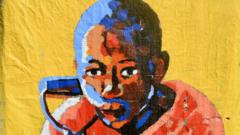Stary Mwaba, a prominent visual artist from Zambia, draws attention to the toxic legacy of the country's "black mountains" through his latest work showcased at the Lusaka National Museum. These towering heaps of mining waste have long been a part of life in the Copperbelt region, which is home to the world's largest copper and cobalt mining.
As a child, Mwaba referred to these hazardous mountains as "mu danger" or "in the danger." Today, they are a source of both toxic waste and meager livelihoods for local youth who risk their lives digging for copper ore. In a region plagued by high unemployment rates, many turn to illegal mining practices to make ends meet, selling their finds to mainly Chinese buyers.
Mwaba captures these themes in his art by creating large, colorful portraits on old newspapers, representing both grand and individual narratives of life in the Wusakile neighborhood. His unique technique involves cutting out articles that resonate with him, then burning portions away to create intricate designs filled with paintings of local figures.
One of his notable works, "Jerabo," portrays a young miner preparing for the hazardous job of lowering himself into a tunnel. Through art workshops, Mwaba has collected the voices of the community, highlighting both hardship and joy. His pieces, like "Shofolo"—a tribute to the essential shovel of a miner—and "Boss for a Day," reflect the struggles faced by young miners feeling exploited yet hopeful.
Having grown up in this environment, Mwaba's transition from exploring the Chinese influence in the mining sector to focusing on the people affected by it has been profound. His recent experiences have fueled a strong emotional response, as he witnesses the poverty and difficult choices faced by his community. Mwaba’s art is not just about the past but serves to elevate the voices of ordinary people caught in a cycle of environmental and economic challenges, creating a narrative that demands attention.
As a child, Mwaba referred to these hazardous mountains as "mu danger" or "in the danger." Today, they are a source of both toxic waste and meager livelihoods for local youth who risk their lives digging for copper ore. In a region plagued by high unemployment rates, many turn to illegal mining practices to make ends meet, selling their finds to mainly Chinese buyers.
Mwaba captures these themes in his art by creating large, colorful portraits on old newspapers, representing both grand and individual narratives of life in the Wusakile neighborhood. His unique technique involves cutting out articles that resonate with him, then burning portions away to create intricate designs filled with paintings of local figures.
One of his notable works, "Jerabo," portrays a young miner preparing for the hazardous job of lowering himself into a tunnel. Through art workshops, Mwaba has collected the voices of the community, highlighting both hardship and joy. His pieces, like "Shofolo"—a tribute to the essential shovel of a miner—and "Boss for a Day," reflect the struggles faced by young miners feeling exploited yet hopeful.
Having grown up in this environment, Mwaba's transition from exploring the Chinese influence in the mining sector to focusing on the people affected by it has been profound. His recent experiences have fueled a strong emotional response, as he witnesses the poverty and difficult choices faced by his community. Mwaba’s art is not just about the past but serves to elevate the voices of ordinary people caught in a cycle of environmental and economic challenges, creating a narrative that demands attention.



















